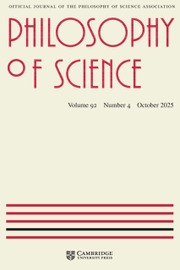No CrossRef data available.
Article contents
The Attractions of “Object Colors”
Published online by Cambridge University Press: 21 March 2025
Abstract
Three popular objections to reductionism about color, experience as of impossible colors, the unary/binary distinction, and structural mismatch, are issues just, I argue, for the (probably default) version of reductionism according to which colors reduce to sets of surface spectral reflectances. They are not problems for the version on which colors are dispositions to reflect coarse-grained intensities of light are—what in colorimetry are called “object colors.” This article sets out to demonstrate the virtues of the latter reductionism.
Information
- Type
- Article
- Information
- Copyright
- © The Author(s), 2025. Published by Cambridge University Press on behalf of the Philosophy of Science Association
References
Allen, Keith. 2016. A Naïve Realist Theory of Colour. Oxford, UK: Oxford University Press.
CrossRefGoogle Scholar
Armstrong, David. 1978. Universals and Scientific Realism: A Theory of Universals (Vol. II). Cambridge: Cambridge University Press.Google Scholar
Bohon, Katherine S., Hermann, Kaitlin L., Hansen, Thorsten, and Conway, Bevil R.. 2016. “Representation of Perceptual Color Space in Macaque Posterior Inferior Temporal Cortex (the V4 Complex).” eNeuro 3 (4):ENEURO-0039. http://doi.org/10.1523/ENEURO.0039-16.2016.CrossRefGoogle ScholarPubMed
Bradley, Peter, and Tye, Michael. 2001. “Of Colors, Kestrels, Caterpillars, and Leaves.” Journal of Philosophy 98 (9):469. https://doi.org/10.2307/2678495.CrossRefGoogle Scholar
Briggs, David. 2021. “Colour Spaces.” In Routledge Handbook of the Philosophy of Colour, edited by Macpherson, Fiona and Brown, Derek. pp. 140–156. London: Routledge.Google Scholar
Byrne, Alex. 2009. “Experience and Content.” Philosophical Quarterly 59 (236):429–51. http://doi.org/10.1111/j.1467-9213.2009.614.x.CrossRefGoogle Scholar
Byrne, Alex, and Hilbert, David R.. 2003a. “Color Realism and Color Science.” Behavioral and Brain Sciences 26 (1):3–21. http://doi.org/10.1017/s0140525x03000013.CrossRefGoogle ScholarPubMed
Byrne, Alex, and Hilbert, David R.. 2003b. “Color Realism Redux.” Behavioral and Brain Sciences 26 (1):52–63. https://doi.org/10.1017/S0140525X03540018.CrossRefGoogle Scholar
Byrne, Alex, and Hilbert, David R.. 2007. “Truest Blue.” Analysis 67 (1):87–92. http://doi.org/10.1093/analys/67.1.87.CrossRefGoogle Scholar
Byrne, Alex, and Hilbert, David R.. 2021. “Objectivist Reductionism.” In Routledge Handbook of the Philosophy of Colour, edited by Macpherson, Fiona and Brown, Derek, 287–98. London: Routledge.Google Scholar
Churchland, Paul M. 2005. “Chimerical Colors: Some Phenomenological Predictions from Cognitive Neuroscience.” Philosophical Psychology 18 (5):527–60. http://doi.org/10.1080/09515080500264115.CrossRefGoogle Scholar
Churchland, Paul M. 2007. “On the Reality (and Diversity) of Objective Colors: How Color-Qualia Space Is a Map of Reflectance-Profile Space.” Philosophy of Science 74 (2):119–49. http://doi.org/10.1086/519027.CrossRefGoogle Scholar
Churchland, Paul M. 2012. Plato’s Camera: How the Physical Brain Captures a Landscape of Abstract Universals. Cambridge, MA: MIT Press.CrossRefGoogle Scholar
Cohen, Jonathan. 2009. The Red and the Real: An Essay on Color Ontology. Oxford: Oxford University Press.CrossRefGoogle Scholar
Crane, Tim. 1988. “The Waterfall Illusion.” Analysis 48 (June):142–47. http://doi.org/10.1093/analys/48.3.142.CrossRefGoogle Scholar
Davies, Will. 2014. “The Inscrutability of Colour Similarity.” Philosophical Studies 171 (2):289–311. http://doi.org/10.1007/s11098-013-0272-x.CrossRefGoogle Scholar
Davies, Will. 2018. “Colour Vision and Seeing Colours.” British Journal for the Philosophy of Science 69 (3): 657–90. http://doi.org/10.1093/bjps/axw026.CrossRefGoogle Scholar
Funt, B. V. 2003. “Imprecise Color Constancy Versus Color Realism.” Behavioral and Brain Sciences 26 (1):29–30. http://doi.org/10.1017/s0140525x03300019.CrossRefGoogle Scholar
Grassmann, Hermann. 1853. “Zur Theorie der Farbenmischung.” Annalen der Physic 165 (5):69–84.CrossRefGoogle Scholar
Hardin, C. L. 2014. “More Color Science for Philosophers.” In Perception and Its Modalities, edited by Stokes, Dustin, Matthen, Mohan, and Biggs, Stephen, 379–90. New York: Oxford University Press.CrossRefGoogle Scholar
Hilbert, David R. 1987. Colour and Colour Perception: A Study in Anthropocentric Realism. Stanford: Center for the Study of Language and Information.Google Scholar
Hilbert, David R., and Eli Kalderon, Mark. 2000. “Color and the Inverted Spectrum.” In Vancouver Studies in Cognitive Science, edited by Davis, Steven, 187–214. New York: Oxford University Press.Google Scholar
Kalderon, Mark Eli. 2011. “The Multiply Qualitative.” Mind 120 (478):239–62. http://doi.org/10.1093/mind/fzr034
CrossRefGoogle Scholar
Koenderink, Jan, and van Doorn, Andrea. 2003. “Perspectives on Colour Space.” In Colour Perception: Mind and the Physical World, edited by Mausfeld, R. and Heyer, D.. Oxford University Press.Google Scholar
Macpherson, Fiona. 2003. Novel colours and the content of experience. Pacific Philosophical Quarterly 84 (1):43–66. http://dx.doi.org/10.1111/1468-0114.00162.CrossRefGoogle Scholar
Macpherson, Fiona. 2021. “Novel Colour Experiences and Their Implications.” In Routledge Handbook of the Philosophy of Colour, edited by Macpherson, Fiona and Brown, Derek, 175–209. London: Routledge.Google Scholar
Manzotti, Riccardo. 2017. “A Perception-Based Model of Complementary Afterimages.” Sage Open 7 (1). https://doi.org/10.1177/215824401668247.CrossRefGoogle Scholar
Pautz, Adam. 2003. “Have Byrne & Hilbert Answered Hardin’s Challenge?” Behavioral and Brain Sciences 26 (1):44–45. http://doi.org/10.1017/s0140525x03460019.CrossRefGoogle Scholar
Pautz, Adam. 2006a. “Can the Physicalist Explain Colour Structure in Terms of Colour Experience?” Australasian Journal of Philosophy 84 (4):535–64. http://doi.org/10.1080/00048400601079094.CrossRefGoogle Scholar
Pautz, Adam. 2006b. “Sensory Awareness Is Not a Wide Physical Relation: An Empirical Argument against Externalist Intentionalism.” Noûs 40 (2):205–40. http://doi.org/10.1111/j.0029-4624.2006.00607.x.CrossRefGoogle Scholar
Pautz, Adam. 2013. “The Real Trouble for Phenomenal Externalists: New Empirical Evidence (with reply by Klein & Hilbert).” In Consciousness Inside and Out: Phenomenology, Neuroscience, and the Nature of Experience, edited by Richard Brown, 237–98. Springer.CrossRefGoogle Scholar
Pridmore, R. W. 2021. “A New Transformation of Cone Responses to Opponent Color Responses.” Attention, Perception, & Psychophysics 83 (4):1797–1803. https://doi.org/10.3758/s13414-020-02216-7
CrossRefGoogle ScholarPubMed
Sharp, William A. 2022. “Russellian Representationalism and the Stygian Hues.” Erkenntnis 89 (2):777–97. http://doi.org/10.1007/s10670-022-00555-5.CrossRefGoogle Scholar
Sharp, William A. 2023. “Spectral Reflectances and Commensurateness.” Erkenntnis: 1–16. https://doi.org/10.1007/s10670-023-00762-8.Google Scholar
Shea, Nicholas. 2007. “Content and Its Vehicles in Connectionist Systems.” Mind and Language 22 (3):246–69. http://doi.org/10.1111/j.1468-0017.2007.00308.x.CrossRefGoogle Scholar
Shoemaker, Sydney. 2003. “Content, Character and Color.” Philosophical Issues 13 (1):253–78. http://doi.org/10.1111/1533-6077.00014.CrossRefGoogle Scholar
Smart, J. J. C. 1975. “On some Criticisms of a Physicalist Theory of Colours.” In Readings on Colour. Vol. 1: The Philosophy of Colour, edited by Byrne, A. and Hilbert, D.. Cambridge, MA: MIT Press.Google Scholar
Stiles, W. S., and Wyszecki, G. W. 1962. “Counting Metameric Object Colors.” JOSA 52(3): 313–28. https://doi.org/10.1364/JOSA.52.000313.CrossRefGoogle Scholar
Tye, Michael. 2000. Consciousness, Color, and Content. Cambridge, MA: MIT Press.CrossRefGoogle Scholar
Tye, Michael. 2006a. “The Puzzle of True Blue.” Analysis 66 (3):173–78. http://doi.org/10.1093/analys/66.3.173.CrossRefGoogle Scholar
Tye, Michael. 2006b. “The Truth about True Blue.” Analysis 66 (4):340–44. http://doi.org/10.1093/analys/66.4.340.CrossRefGoogle Scholar

